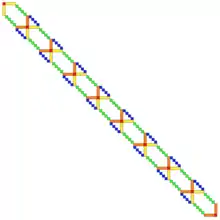Rybicki Press algorithm
The Rybicki–Press algorithm is a fast direct algorithm for inverting a matrix, whose entries are given by , where .[1] It is a computational optimization of a general set of statistical methods developed to determine whether two noisy, irregularly sampled data sets are, in fact, dimensionally shifted representations of the same underlying function.[2][3] The most common use of the algorithm is in the detection of periodicity in astronomical observations.[3]

Recently, this method has been extended (Generalized Rybicki Press algorithm) for inverting matrices whose entries of the form .[4] The key observation in the Generalized Rybicki Press (GPP) algorithm is that the matrix is a semi-separable matrix with rank . More precisely, if the matrix has a semi-separable rank is , the cost for solving the linear system and obtaining the determinant of the matrix scales as , thereby making it extremely attractive for large matrices. This implementation of the GPP algorithm can be found here.[5] The key idea is that the dense matrix can be converted into a sparser matrix of a larger size (see figure on the right), whose sparsity structure can be leveraged to reduce the computational complexity.
The fact that matrix is a semi-separable matrix also forms the basis for celerite[6] library, which is a library for fast and scalable Gaussian Process (GP) Regression in one dimension[7] with implementations in C++, Python, and Julia. The celerite method[7] also provides an algorithm for generating samples from a high-dimensional distribution. The method has found attractive applications in a wide range of fields, especially in astronomical data analysis.[8][9]
References
- Rybicki, George B.; Press, William H. (1995), "Class of fast methods for processing Irregularly sampled or otherwise inhomogeneous one-dimensional data", Physical Review Letters, 74 (7): 1060–1063, arXiv:comp-gas/9405004, Bibcode:1995PhRvL..74.1060R, doi:10.1103/PhysRevLett.74.1060, PMID 10058924

- Rybicki, George B.; Press, William H. (October 1992). "Interpolation, realization, and reconstruction of noisy, irregularly sampled data". The Astrophysical Journal. 398: 169. Bibcode:1992ApJ...398..169R. doi:10.1086/171845.

- MacLeod, C. L.; Brooks, K.; Ivezic, Z.; Kochanek, C. S.; Gibson, R.; Meisner, A.; Kozlowski, S.; Sesar, B.; Becker, A. C. (2011-02-10). "Quasar Selection Based on Photometric Variability". The Astrophysical Journal. 728 (1): 26. arXiv:1009.2081. Bibcode:2011ApJ...728...26M. doi:10.1088/0004-637X/728/1/26. ISSN 0004-637X.
- Ambikasaran, Sivaram (2015-12-01). "Generalized Rybicki Press algorithm". Numerical Linear Algebra with Applications. 22 (6): 1102–1114. arXiv:1409.7852. doi:10.1002/nla.2003. ISSN 1099-1506.
- "sivaramambikasaran/ESS". GitHub. Retrieved 2018-04-05.
- "celerite — celerite 0.3.0 documentation". celerite.readthedocs.io. Retrieved 2018-04-05.
- Foreman-Mackey, Daniel; Agol, Eric; Ambikasaran, Sivaram; Angus, Ruth (2017). "Fast and Scalable Gaussian Process Modeling with Applications to Astronomical Time Series". The Astronomical Journal. 154 (6): 220. arXiv:1703.09710. Bibcode:2017AJ....154..220F. doi:10.3847/1538-3881/aa9332. ISSN 1538-3881.
- Foreman-Mackey, Daniel (2018). "Scalable Backpropagation for Gaussian Processes using Celerite". Research Notes of the AAS. 2 (1): 31. arXiv:1801.10156. Bibcode:2018RNAAS...2a..31F. doi:10.3847/2515-5172/aaaf6c. ISSN 2515-5172.
- Parviainen, Hannu (2018). "Bayesian Methods for Exoplanet Science". Handbook of Exoplanets. Springer, Cham. pp. 1–24. arXiv:1711.03329. doi:10.1007/978-3-319-30648-3_149-1. ISBN 9783319306483.
.